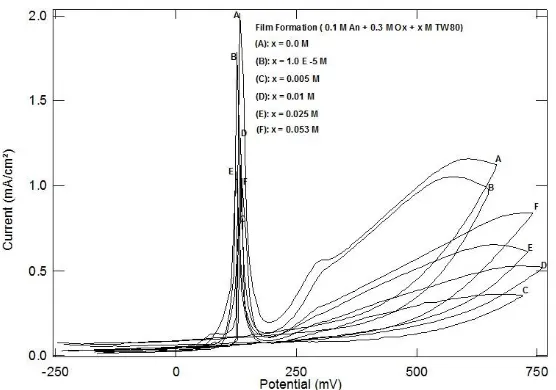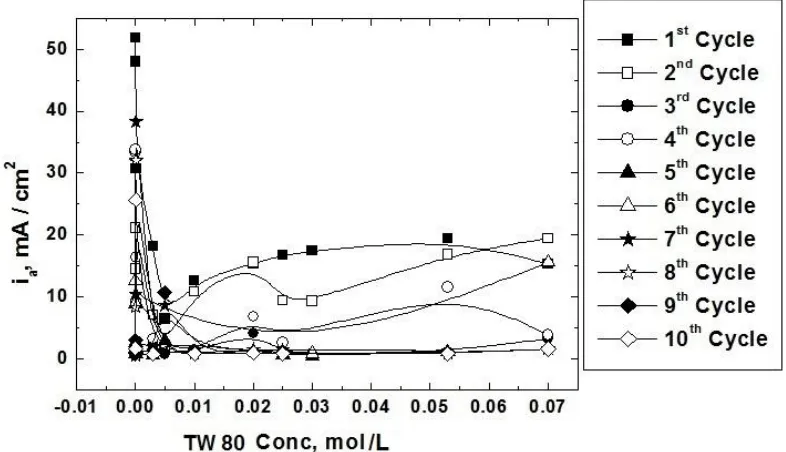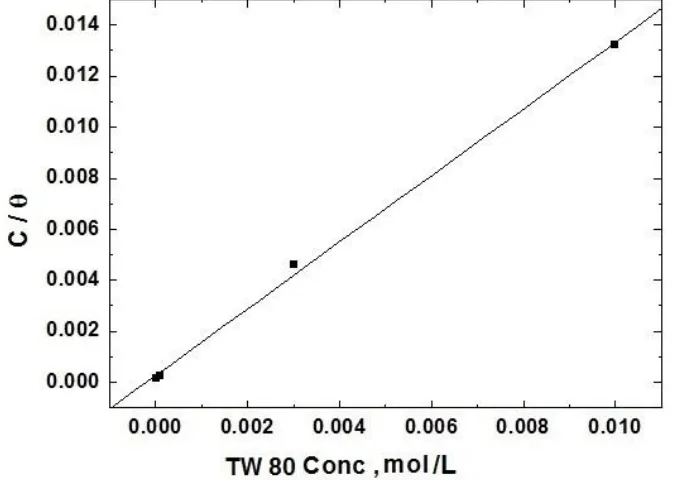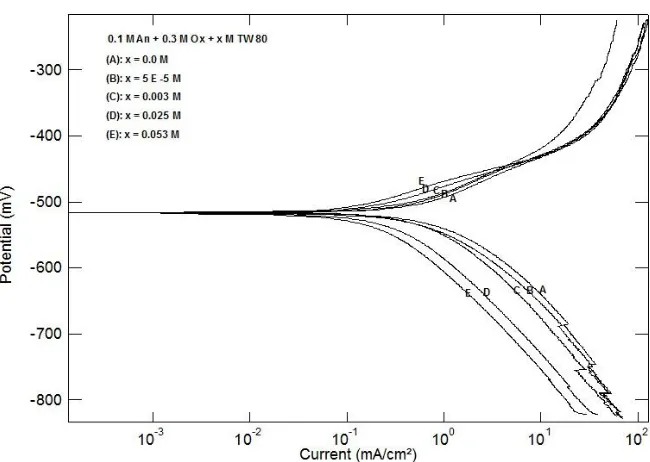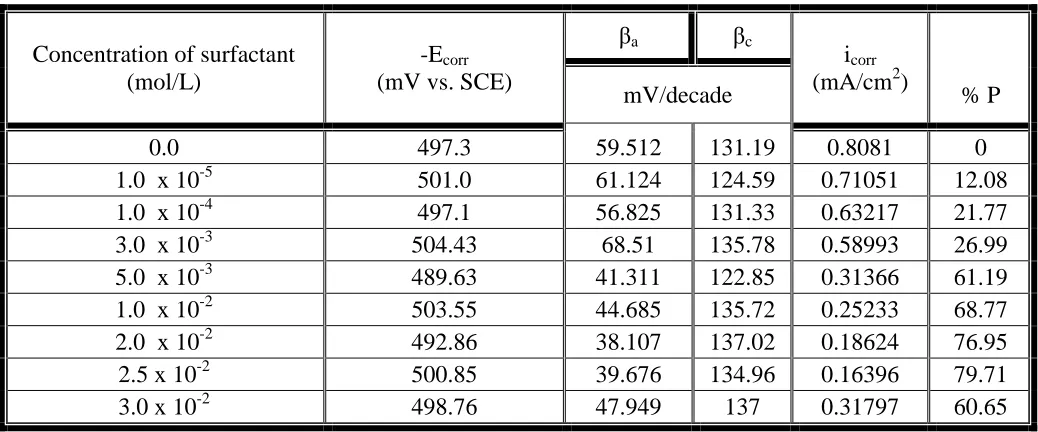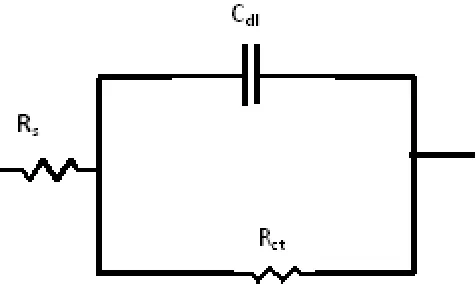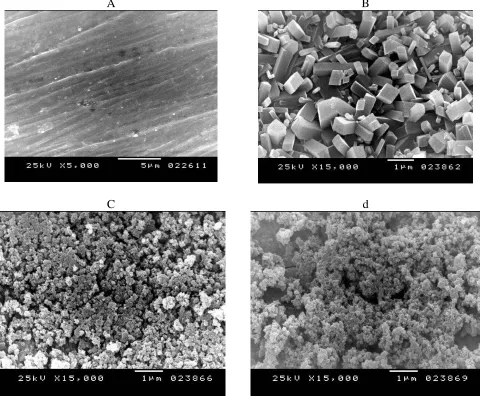Int. J. Electrochem. Sci., 11 (2016) 2721 - 2733
International Journal of
ELECTROCHEMICAL
SCIENCE
www.electrochemsci.org
Effect of Tween 80 Surfactant on the Electropolymerization and
Corrosion Performance of Polyaniline on Mild Steel
B. A. Abd-El-Nabey1,*, O. A. Abdullatef3, G. A. El-Naggar2, E. A. Matter2 and R. M. Salman2 1
Faculty of Science, Chemistry Department, Alexandria University, P.O.Box 426, Alexandria 21321, Egypt
2
Faculty of Science, Damanhur University, Damanhur, Egypt 3
Pharos University, Faculty of Pharmacy, Alexandria, Egypt *
E-mail: beshirabdelnaby2015@gmail.com
Received: 1 January 2016 / Accepted: 8 February 2016 / Published: 1 March 2016
Polyaniline conducting polymer have been electropolymerized from aniline monomer on mild steel surface by cyclic voltametry method in aqueous oxalic acid solution and different concentrations of Tween 80 as surfactant. Characterization of coatings was carried out by scanning electron microscope SEM. Corrosion behavior of the polymer coated mild steel electrodes was investigated in 0.5 M H2SO4 solution by potentiodynamic polarization and electrochemical impedance spectroscopy EIS. Adsorption of the polymer on the metal surface was examined by applying the Langumir adsorption isotherm to fit the experimental data. The mechanism of action of the surfactant in the electropolymerization process has been investigated and discussed.
Keywords: Electropolymerization, surfactant, polyaniline, corrosion, impedance.
1. INTRODUCTION
In recent years, there has been great interest on the possibility of using conducting polymers not only as film former, corrosion inhibitors but also as protective coatings. Conducting polymers, exhibit high conductivity, excellent stability which are expected to have useful properties within the field of corrosion protection [1].
The advantages of conductive polymers such as polyaniline (PAni) are the ease of their electrodeposition, low toxicity, low impact on environment and human health and economical production methods. PAni has been deposited on passive metals such as; SS and Pt [3-16] and active metals such as; Cu and Fe [17, 18, 19-34] by different electrochemical techniques such as: potentiodynamic (cyclic voltammetry), potentiostatic , galvanodynamic and galvanostatic techniques.
There is a wide gap between the oxidation potentials of the monomers of the conductive polymers and the very low oxidation potentials of oxidizable metals and it is the main problem in the electrocoating process is the oxidation of the metal takes place before the oxidation potential of the monomer can be reached, which prevents the growth of conductive polymers on its surface. In order to avoid this problem, the dissolution rate would be slowed down through the findings of optimal conditions [35]. To obtain such a result, there are two solutions: one of them is to control the properties of the polymer coatings such as; technique of polymerization, concentration of the electrolyte and type of the monomer and its concentration, type of solvent, pH and synthesis temperature and the other solution is to make passivation of mild steel electrode surface through linear sweep voltammetry and this process is followed by electropolymerization of monomers without changing the polymerization solution [34].
Many electroplating and electropolymerization processes were carried out in presence of surfactants. Le Chen et.al [36] investigated the influence of the concentration of surfactant hexadecyl pyridinium bromide (HPB) on the amount of Al2O3 particles in the coatings and property of nickel matrix. The results indicated that the addition of HPB improved the deposited amount of Al2O3 and achived a more uniform distribution of Al2O3 particles in the nickel matrix. Anionic surfactant sodium dodecyl sulfate (SDS) and cationic surfactant hexadecyl trimethyl ammonium bromide (HTAB) are frequently used in electrodeposition [37-42].
Bazzaoni et.al, [43] suggested a new method for depositing polythiophene films on iron and platinum electrodesby electrochemical oxidation of bithiophene in an aqueous micellar medium. The experimental data indicated that SDS increases the solubility of thiophene in water, lowers its oxidation potential and inhibits the dissolution of iron. Polythiophene films prepared by this technique were very homogeneous and adherent to the electrode surface. SDS surfactant has been used by several authors [13, 34, 44-45] in preparing conducting polymer coats electrochemically.
Although, all these references mention the importance of adding surfactant during electropolymerization, they did not address the mechanism of action of the surfactant in the polymerization.
The aim of this work is to investigate the effect of surfactant (Tween 80) on the electropolymerization and corrosion performance of polyaniline on mild steel. The role of the surfactant and the mechanism of its action in the electroplolymerization process will be discussed.
2. EXPERIMENTAL
Fe. Platinum sheet was used as auxillary electrode and saturated calomel electrode (SCE) as reference electrode. The working electrode is 6 mm diameter embedded in Teflon holder. Before each experiment, the working electrode was polished with a series of emery papers of different grit sizes (320-1000). After polishing, the working electrode was washed with double distilled water and dried at room temperature. The electropolymerization of aniline monomers was carried out on the passivated mild steel electrode. The passivation process was performed between -500 and 300 mV versus SCE at 4 mV/sec scan rate by the linear sweep voltammetry technique in 0.3 M oxalic acid containing 0.1 M aniline in absence and presence of different concentrations of TW 80 surfactant. After that, the coatings were prepared electrochemically on the passivated MS by the cyclic sweep voltammetry technique between 300 and 1200 mV at 10 mV/sec scan rate with out changing the polymerization solution. The coated metal was immersed in double distilled water to remove adsorbed electrolytes and the soluble oligomers formed during electropolymerization of the coating and then dried for 1 h at room temperature before corrosion measurements and SEM studies. All electrochemical studies were carried out with 604 Gill ACM instrument. SEM was employed to characterize the surface morphology with JOEL instrument. Anti-corrosion control of the coated electrodes was studied by potentiodynamic polararization and electrochemical impedance measurements in 0.5 M H2SO4 The frequency range for EIS measurements was 0.01 ≤ f ≤ 3 x 104Hz with
an applied potential signal amplitude of 10 mV around the rest potential. Polarization curves measurements were carried out at scan rate 20 mV/min. Aniline (98.5%) was purified by filtration using Al2O3 and stored in a dark and cool place before use.
3. RESULTS AND DISCUSSION
3.1 Electropolymerization of aniline monomer on mild steel by cyclic voltammetry in absence and presence of Tween 80.
[image:3.596.164.442.532.727.2]
In order to obtain well adhering conducting polyaniline coatings 10 cycles of the electropolymerization of 0.1 M aniline in 0.3 M oxalic acid and different concentrations of tween (TW 80) surfactant were carried out at scan rate 10 mV/sec.
Figure 1, represents the third cyclic voltamograms recorded for mild steel electrode at 10 mV/sec in absence and presence of different concentrations of TW 80 during electropolymerization of 0.1 M aniline in 0.3 M oxalic acid. The behavior described in the figure was characterized by reference to specific peaks in the cyclic voltamograms. In all cycles, during the forward scan there is a large peak corresponding to the dissolution of the mild steel in oxalic acid appears at 130 mV. The remarkable peak observed at 300 mV was attributed to the oxidation of the monomer to form polyaniline on oxidizable MS. The height of the two peaks decreased by increasing the concentration of the surfactant. This behavior can be discussed on the basis of the adsorption of the surfactant molecules at the steel/solution interface which inhibits the oxidation process of steel and monomer. Figure 2, represents the variation of the anodic current obtained from the ten cyclic voltamograms in presence of different concentrations of TW 80. It is clear from this figure, that in all cycles the anodic current decrease with increasing the surfactant concentration reaching a limiting value. This limiting anodic current value decrease with increasing the number of cycles from 1 to 5. For the cycles from 6 to 10, the anodic current limiting value becomes near zero, indicating that passivation of MS occurs in presence of the surfactant.
Figure 2. The variation of the anodic current obtained from the recorded cyclic voltammograms for MS electrode in 0.3 M oxalic acid solution during electropolymerization of 0.1 M of aniline in presence of different concentrations of TW 80 at 130 mV.
3.2. Inhibition of the oxidation of steel by the surfactant TW 80.
[image:4.596.95.488.388.614.2]
Figure 3. Variation of anodic current at 130 mV with the concentration of TW 80 in the first cycle.
It is clear that the increase of the concentration of the surfactant leads to the decrease of the anodic current of steel which indicating that the presence of the surfactant in the medium of polymerization inhibits the oxidation of the steel.
Figure 4. Variations of the percentage inhibition of TW 80 for oxidation of steel with its concentration in the first cycle.
The inhibition efficiency of Tween 80 to the oxidation of steel can be calculated from the equation:
% P = [(ia0 – ia) / ia0] x 100
[image:5.596.147.442.75.301.2] [image:5.596.162.433.423.630.2]
concentration of the surfactant.
Figure 4 shows the relation between the % P of the oxidation of steel by Tween 80 and the concentration of the surfactant. This relation represents an adsorption isotherm indicating that the inhibition of the oxidation of steel is probably by adsorption of the surfactant at the steel surface.
Figure 5 represents the fitting of Langumir adsorption isotherm for the experimental data obtained from the variation of the anodic current of steel with the concentration of TW 80.
Figure 5. Application of the Langmuir isotherm to fit the experimental results of adsorption of TW 80 on the steel surface. concentrations of TW 80 on steel surface.
The figure indicates that the results were best fitted by Langumir adsorption isotherm equation [46-49].
C/θ = 1/K + C (1)
Where C is the concentration of inhibitor, K the adsorptive equilibrium constant and θ is the surface coverage by inhibitor molecules.
Langumir isotherm is found to be valid due to the linearity of the graph which slope near to unity.
This indicates that the adsorption of TW 80 surfactant molecules on the steel surface is ideal and there is no mutual interaction between its molecules. The binding constant K is related to the standard free energy of adsorption ∆G◦ads according to the following equation [50-52]:
K = 1/55.5 exp (-∆G◦ads /RT) (2)
Where; R is the universal gas constant, T is the absolute temperature, the value 55.5 is the concentration of water in solution expressed in mol/L.
[image:6.596.131.469.180.420.2]
The value of K equal 2779.7 obtained from Langumir isotherm gives ∆G◦ads equals -30.01 kJ/mol. This value indicates that the adsorption of Tween 80 on the steel surface is mainly physical in nature.
In our recent previous work [54], ∆G◦ads of the adsorption of Cetrimide cationic surfactant calculated from the results of dissolution of steel in 0.5 M H2SO4 was found to be -35.9 kJ/mol indicative that adsorption is comprehensive (physical and chemical).
In another work [55,56], ∆G◦ads of adsorption of dodecyl trimethyl ammonium chloride (DTAC) surfactant on carbon steel in 0.5 M HCl solution was calculated and found to be -39.8 kJ/mol indicating a spontaneous adsorption of the surfactant on steel surface which suggests a comprehensive adsorption might be occur.
∆G◦ads of adsorption of Cefatoxime sodium on steel surface was calculated from the results of dissolution of steel in HCl was calculated and found to be -19.3 kJ/mol suggesting that the adsorption is characterized by physisorption [57].
The adsorption of Triton X-114 surfactant on the steel surface was studied and ∆G◦ads was found to be -34.06 kJ/mol suggesting a strong physical adsorption of Triton X-114 on the steel surface [58].
∆G◦ads for adsorption of N,N,N-tributyl-1-butan ammonium bromide on the steel surface was calculated from the results of dissolution of steel in 0.5 M H2SO4 and found to be -31.1 kJ/mol indicating the spontaneous physical adsorption process [59].
3.3 Anti-corrosive properties of polyaniline coating 3.3.1. Potentiodynamic polarization results.
[image:7.596.138.463.477.708.2]
Table 1. Electrochemical polarization parameters of polyaniline-coated mild steel using Tween 80 in 0.5 M sulphuric acid solution in presence of different concentrations of TW 80.
Concentration of surfactant (mol/L)
-Ecorr (mV vs. SCE)
βa βc
icorr (mA/cm2)
mV/decade % P
0.0 497.3 59.512 131.19 0.8081 0
1.0 x 10-5 501.0 61.124 124.59 0.71051 12.08
1.0 x 10-4 497.1 56.825 131.33 0.63217 21.77
3.0 x 10-3 504.43 68.51 135.78 0.58993 26.99
5.0 x 10-3 489.63 41.311 122.85 0.31366 61.19
1.0 x 10-2 503.55 44.685 135.72 0.25233 68.77
2.0 x 10-2 492.86 38.107 137.02 0.18624 76.95
2.5 x 10-2 500.85 39.676 134.96 0.16396 79.71
3.0 x 10-2 498.76 47.949 137 0.31797 60.65
Figure 6 shows the influence of the presence of different concentrations of the surfactant TW 80 in the medium of polymerization of aniline on the polarization curves of the coated steel in 0.5 M H2SO4. The values of the corrosion current density (icorr) for the investigated coated steel without and with the surfactant were determined by the extrapolation of cathodic and anodic Tafel lines to the corrosion potential (Ecorr) and represented in table 1. It can be seen that the presence of TW 80 during the polymerization process affect both the cathodic and anodic polarization curves, indicating that the polyaniline polymer block both the cathodic and anodic areas and inhibit the corrosion reactions [1,60]. Data in table 1 exhibited that the corrosion current density (icorr) decreases, and the protection efficiency of the coat (% P) increases as the concentration of Tween 80 is increased. The fact that the slopes of the cathodic and anodic Tafel lines (βc) and (βa) remain almost unchanged upon addition of the surfactant, indicating that TW 80 act simply by blocking the available surface areas.
3.3.2. Electrochemical impedance spectroscpic results.
Electrochemical impedance measurements is used for the evaluation of anticorrosive properties of polyaniline coatings. Figure 7, represents Nyquist plots for coated mild steel in 0.5 M H2SO4. The influence of the presence TW 80 during the polymerization process on the Nyquist plots of coated mild steel in 0.5 M H2SO4 solution manifested only one depressed capacitive semicircle. The diameter of the semicircle increases with increasing the surfactant concentration. The impedance spectra for different Nyquist plots were analyzed by fitting the experimental data using Zsimpwin program to a simple equivalent circuit model represented in figure 8.
0. 1M An + 0.3 M H
2SO4 + x M TW 80
(A): x = 0.0 M (B): x = 1E-5 M (C): x = 1E-4 M (D): x = 0.003 M (E): x = 0.005 M (F): x = 0.01 M (G): x = 0.02 M (H): x = 0.025 M (I): x = 0.03 M (J): x = 0.053 M
Figure 7. Nyquist plots of polyaniline-coated mild steel in presence of different concentrations of Tween 80 in 0.5 M sulphuric acid solution.
Figure 8. The equivalent circuit model.
The equivalent circuit model includes the solution resistance Rs and the double layer capacitance Cdl which is placed in parallel to the charge transfer resistance element Rct. The values of the electrochemical parameters and the protection efficiency of the coat (% P) which polymerized in presence of different TW 80 concentrations are given in table 2. The results show that, Rct values increase with increasing the TW 80 concentration. The increase of Rct values suggests the increase of the corrosion resistance of the polymer coat. The protection efficiency was calculated from impedance measurements using the relation:
% P = [(Rct – Rct0) / Rct] x 100
[image:9.596.92.519.94.281.2] [image:9.596.162.400.354.505.2]
Table 2. Electrochemical impedance parameters for polyaniline-coated mild steel using Tween 80 as surfactant in 0.5 M sulphuric acid solution.
% inhibition Rct
(Ohm.cm2) Cdl
(µF) Rs
(Ohm.cm2) Concentration of surfactant
(mol / L)
0 17.87 246 1.311 0.0 14.82 20.98 263 1.168
1.0 x 10-5
27.71 24.72
204 1.199
1.0 x 10-4
32.52 26.48
178 1.328
3.0 x 10-3
40.23 29.9
136 1.323
5.0 x 10-3
51.87 37.13
114 1.279
1.0 x 10-2
67.53 55.04
228 1.626
2.0 x 10-2
79.24 86.09
64.9 0.9142
2.5 x 10-2
81.62 97.23
127 1.063
3.0 x 10-2
83.14 106
58.3 0.8125
5.3 x 10-2
The variation of the protection efficiency of the polyaniline coat with the concentration of the TW 80 is shown in figure 9. The curve is characterized by an initial steeply rising part and at higher concentrations the protection efficiency of the coat was constant. This behavior leads to the suggestion that the polymerization process is mainly controlled by adsorption of the surfactant molecules at the steel/solution interface.
[image:10.596.133.468.455.708.2]
3.4 Surface morphological studies
[image:11.596.314.538.287.689.2]Figure 10 shows the micrographs of the electrodes, recorded for bare steel or steel after running cyclic voltammetry experiments in absence or presence of TW 80 surfactant. Figure 10a, represents SEM for bare steel which shows clear visible polishing marks on the surface. Figure 10b, represents SEM for steel after running cyclic voltammetry experiment in 0.1 M Aniline and 0.3 M oxalic acid. The crystalline structure observed may be due to the deposition of oxalate anion on the metal surface. Figures 10c and 10d represent SEM for steel after running the cyclic voltammetry experiment in 0.1 M aniline and 0.3 M oxalic acid in presence of 0.005 and 0.05 M TW 80 respectively, as surfactant. This figure shows that the morphology of the polyaniline polymer is similar to the nodular structure formed by the aggregation of spherical grains which is compatible with the literature [34]. It is clear that the nodular structure becomes cloudy in presence of higher concentrations of TW 80 (figure 10d).
A B
[image:11.596.60.540.289.692.2]C d
4. CONCLUSIONS
1. The presence of TW 80 in the polymerization medium of polyaniline leads to the inhibition of the oxidation of each of steel and aniline.
2. The inhibition of the oxidation of steel by TW 80 is controlled by adsorption of the surfactant molecules at the steel/solution interface and the experimental results fits the Langumir adsorption isotherm giving ∆G◦ads = -30.01 kJ/mol indicative that the adsorption of the TW80 molecules at the steel/solution interface is mainly physical in nature.
3. The potentiodynamic polarization and electrochemical impedance results of polyaniline coated steel in 0.5 M H2SO4 indicated that the protection efficiency of the polymer coat to the corrosion of steel increases to about 80 % at 0.025 M TW80.
4. The SEM micrographs indicated that the morphology of the aniline polymer is similar to the nodular structure formed by the aggregation of spherical grains.
References
1. N. O. Pekmez, E. Abaci, K. Cinkilli, A. Yagan, Prog. Org. Coatings, 65 (2009) 462-468. 2. K. Yamada, K. Teshima, N. Kobayashi, R. Hirohashi, J. Electroanal. Chem., 394 (1995) 71-79. 3. P. A. Kilmartin, L. Trier, G. A. Wright, Synth. Met., 131 (2002) 99-109.
4. G. Bereket, E. Hϋr, Y. Șahin, Appl. Surf. Sci., 252 (2005) 1233-1244. 5. E. Hϋr, G. Bereket, Y. Șahin, Prog. Org. Coat., 57 (2006) 149-158. 6. E. Hϋr, G. Bereket, Y. Șahin, Current Applied Physics, 7 (2007) 597-604. 7. A. T. Ozyιlmaz, M. Erbil, B. Yazιcι, Thin Solid Films, 496 (2006) 431-437.
8. D. Sazou, M. Kourouzidou, E. Pavlidou, Electrochimica Acta, 52 (2007) 4385-4397. 9. A. Yağan, N. Ő. Pekmez, A. Yιldιz, Corros. Sci., 49 (2007) 2905-2919.
10.N. Ő. Pekmez, E. Abacι, K. Cιnkιllι, A. Yağan, Prog. Org. Coat., 65 (2009) 462-468. 11.D. P. Le, Y. H. Yoo, J. G. Kim, S. M. Cho, Y. K. Son, Corros. Sci., 51 (2009) 330-338. 12.H. Lu, Y. Zhou, S. Vongehr, K. Hu, X. Meng, Synth. Met., 161 (2011) 1368-1376. 13.N. Ő. Pekmez, K. Cιnkιllι, B. Zeybek, Prog. Org. Coat., 77 (2014) 1277-1287.
14.S. M. Sayyah, M. M. El-Rabiey, H. El-Feky, A. F. Gaber, Int. J. Polym. Mater., 55 (2006) 1-20. 15.S. M. Sayyah, M. M. El-Rabiey, S. S. Abd El-Rehim, R. E. Azooz, J. Appl.Polym. Sci., 99 (2006)
3093-3109.
16.S. M. Sayyah, M. M. El-Rabiey, S. S. Abd El-Rehim, R.E. Azooz, J. Appl.Polym. Sci., 109 (2008) 1643-1653.
17.B. Trachli, M. Keddam, H. Takenouti, A. Srhiri, Corros. Sci., 44 (2002) 997-1008. 18.V. Shinde, S. R. Sainkar, P. P. Patil, Corros. Sci., 47 (2005) 1352-1369.
19.E. A. Bazzaoui, S. Aeiyach, P. C. Lacaze, Synth. Met., 83 (1996) 159-165. 20.D. Sazou, C. Georgolios, J. Electroanal. Chem., 429 (1997) 81-93.
21.J. L. Camalet, J. C. Lacroix, S. Aeiyach, K. I. Chane-ching, P. C. Lacaze, Synth.Met., 93 (1998) 133-142.
22.J. L. Camalet, J. C. Lacroix, S. Aeiyach, P. C. Lacaze, J. Electroanal. Chem., 445 (1998) 117-124. 23.J. L. Camalet, J. C. Lacroix, T. Dung Nguyen, S. Aeiyach, M. C. Pham, J.Petitjean, P. C. Lacaze, J.
Electroanal. Chem., 485 (2000) 13-20.
24.J. C. Lacroix, J. L. Camalet, S. Aeiyach, K. I. Chane-ching, J. Petitjean, E.Chauveau, P. C. Lacaze, J. Electroanal. Chem., 485 (2000) 13-20.
27.A. M. Fenelon, C. B. Breslin, Synth. Met., 144 (2004) 125-131.
28.J. I. Martins, T. C. Reis, M. Bazzaoui, E. A. Bazzaoui, L. Martins, Corros. Sci., 46 (2004) 2361-2381.
29.A. Yağan, N. Ő. Pekmez, A. Yildiz, J. Electroanal. Chem., 578 (2005) 231-238.
30.J. Bonastre, P. Garcés, F. Huerta, C. Quijada, L. G. Andión, F. Cases, Corros. Sci., 48 (2006) 1122-1136.
31.S. M. Sayyah, M. M. El-Rabiey, H. El-Feky, A. F. Gaber, Int. J. Polym. Mater., 56 (2007) 605-628.
32.A. P. Srikanth, V. Raman, S. Tamilselvi, S. Nanjundan, N. Rajendran, Anti-Corrosion Methods and Materials, 55 (2008) 3-9.
33.R. Hasanov, S. Bilgiҫ, Prog. Org. Coat., 64 (2009) 435-445.
34.B. Zeybek, N. Ő. Pekmez, E. Kιlιҫ, Electrochim. Acta, 56 (2011) 9277-9286.
35.C. A. Ferreira, S. Aeiyach, J. I.Aaron, P. C. Lacaze, Electrochim. Acta, 41 (1994) 351-357. 36.Li Chem, L. Wang, Z. Zeng, J. Zhang, Mter. Sci. Eng. A, 434 (2006) 319-325.
37.S. K. Khameneh, M. H. Sohi, A. Ataie, J. Ultrafine and Nanostructured Materials, 47 (2014) 51-56.
38.C. Cuo, Y. Zuo, X. Zhao, J. Zhao, J. Xiong, J. Surf. Coatings Technol., 202.(2008).3385-3390. 39.E. Gomez, S. Pane, X. Alcobe, E. Valles, Electrochim. Acta, 51.(2006).5703-5709.
40.M. D. Ger, K. H. Hou, B. J. Hwang, Mater. Chem. Phys. 87.(2004).341-350. 41.L. Liao, W. Liu, X. Xiao, Electroanal. Chem., 566 (2004)341-350.
42.B. Crozier, Q. Lin, D. G. Ivery, J. Mater. Sci. Mater Electron., 22 (2011) 614-625. 43.E. A. Bazzaoni, S. Aeiyach, P. C. Lacaze, Synthetic Materials, 83 (1966) 159-165. 44.M. Wang, H. Zhang, C. Wang, X. Hu, G. Wang, Electrochim. Acta, 91 (2013) 14-151. 45.N. O. Pekmez, E. Abaei, K. Cinkilli, A. Yugan, Prog. Org. Coat., 65 (2009) 462-468. 46.X. H. Li, S. D. Deng, G. N. Mu, H. Fu, F. Z. Yang, Corros. Sci., 50 (2008) 420-430. 47.G. N. Mu, X. H. Li, J. Colloid Interface Sci., 2289 (2005) 184-192.
48.X. H. Li, G. N. Mu, Appl. Surf. Sci., 252 (2005) 1254-1265.
49.X. H. Li, S. D. Deng, H. Fu, G. N. Mu, Mater. And Corros., 60 (2009 )969-979.
50.W. H. Li, Q. He, S. T. Zhang, C. L. Pei, B. R. Hou, J. Appl. Electrochem., 38 (2008) 289-295. 51.E. Khamis, Corrosion, 46 (1990) 476-484.
52.G. Moretti, F. Guidi, G. Grion, Corros. Sci., 46 (2004) 387-403.
53.B. A. Abd-El-Naby, A. A. El-Awady, S. G. Aziz Corros. Prev. Control., 38 (1991) 68-74.
54. B. A. Abd-El-Naby, O. A. Abdullatef, E. Khamis, W. A. El-Mahmody Int. J. Electrochem. Sci., 11 (2016) xx - yy
55. A.S. Fouda, A.A. Al-Sarawy, E.E. El-Katori, Desalination 201(2006)1. 56. D.A. Lo'pez, S.N. Simson, S.R. de Sa'nchez, Corros. Sci.,47(2005)735. 57. S.K. Shukla, M.A. Quraishi Corr. Sci., 51(2009)1007.
58. A.A. Abdel Fattah, A.M. Attit, A.I. Ali, A.Y. El-Etre J. Basic and Environment. Sci., 1(2014)24. 59. B.S. Prathibha, P. Kotteeswaran, V. Bheema Raju Knowledge of Research 1(2014)54.
60. B. Duran, M.C. Turhan, G. Bereket, A.S. Sarac Electrochim. Acta 55(2009)104.
